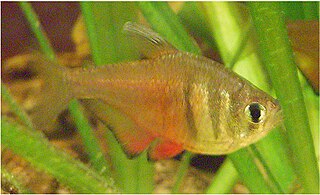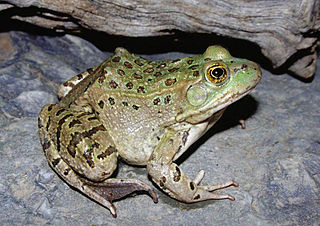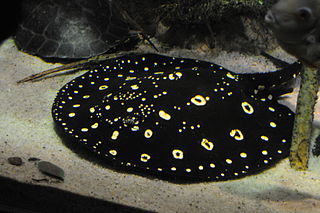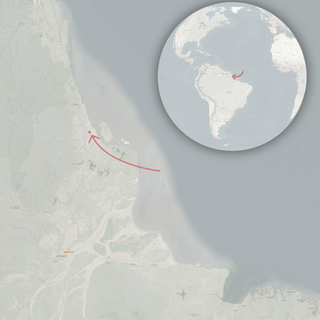
The arapaima, pirarucu, or paiche is any large species of bonytongue in the genus Arapaima native to the Amazon and Essequibo basins of South America. Arapaima is the type genus of the subfamily Arapaiminae within the family Osteoglossidae. They are among the world's largest freshwater fish, reaching as much as 3 m (9.8 ft) in length. They are an important food fish. They have declined in the native range due to overfishing and habitat loss. In contrast, arapaima have been introduced to several tropical regions outside the native range, where they are sometimes considered invasive species. In Kerala, India, arapaima escaped from aquaculture ponds after floods in 2018. Its Portuguese name, pirarucu, derives from the Tupi language words pira and urucum, meaning "red fish".

Arapaima gigas, also known as pirarucu or simply arapaima, is a species of arapaima native to the basin of the Amazon River. Once believed to be the sole species in the genus, it is among the largest freshwater fish. The species is an obligate air breather, so it needs to come to the surface regularly to breathe air.

The silver trout is an extinct char species or subspecies that inhabited a few waters in New Hampshire in the United States prior to 1939, when a biological survey conducted on the Connecticut watershed by the New Hampshire Fish and Game Department found none.

The ocellate river stingray, also known as the peacock-eye stingray or black river stingray, is a species of freshwater stingray in the family Potamotrygonidae. It was the first species to be described in the family and is also the most widespread, ranging throughout much of the Río de la Plata, Amazon, Mearim and Orinoco basins in tropical and subtropical South America. It is sometimes kept in aquaria.

The Atlantic croaker is a species of marine ray-finned fish belonging to the family Sciaenidae and is closely related to the black drum, the silver perch, the spot croaker, the red drum, the spotted seatrout, and the weakfish. It is commonly found in sounds and estuaries from Massachusetts to the Gulf of Mexico.

Orestias is a genus of pupfish. Older systematics classified them into the own family Orestiidae. They are found in lakes, rivers and springs in the Andean highlands of South America, and several species are considered threatened. They are egg-laying fish that feed on small animals and plant matter. The largest species can reach a total length of 27 cm (10.6 in), but most remain far smaller. Their most characteristic feature is the absence of the ventral fin, although this is shared by a few other pupfish. Despite their moderate to small size, they are important to local fisheries and a few species are farmed.

The flame tetra, also known as the red tetra or Rio tetra, is a small freshwater fish of the characin family Characidae. This tetra was first introduced as aquarium fish in 1920 by C. Bruening, Hamburg, Germany, and formally described in 1924 by Dr. George S. Myers. Today large numbers are bred in captivity and it is common in the aquarium trade, but the remaining wild population in Southeast Brazil is highly threatened.

Labeobarbus somereni, or Someren's barb, is a species of ray-finned fish in the family Cyprinidae. It is found in Burundi, Rwanda, Tanzania, and Uganda. Its natural habitat is rivers. It is not considered a threatened species by the IUCN. Local names for the fish in Rwanda include ikinanga, inkwenwe, ifurwe (Satinsyi) and urwozi (Nyabarongo).
Phrynomedusa fimbriata, the spiny-knee leaf frog, is an extinct species of tree frog. It was endemic to Brazil, where the only known specimen was discovered near Paranapiacaba in the state of São Paulo. The type locality was given as Alto da Serra. While the species might still exist, having only been found once in the 1898, no trace of any individuals have been discovered in successive expeditions.

The Chiricahua leopard frog is a species of frog in the family Ranidae, the true frogs.

The northern snake-necked turtle or northern long-necked turtle is a species of turtle in the family Chelidae or Austro-South American Side-necked Turtles. It is native to northern Australia and southern New Guinea.

The bigtooth river stingray or Tocantins River ray is a species of freshwater fish in the family Potamotrygonidae. It is endemic to the lower Tocantins basin and Araguaia basin in Brazil, and prefers muddy bottoms. It is sometimes kept in aquaria. This stingray is generally common and its population increased after the Tucuruí Dam was completed, unlike many other species in its range.
Enteromius baudoni is a species of tropical cyprinid freshwater fish from Central and Western Africa. It is found in western Africa, in the river basins of the Chad Basin, the Volta basin, the Niger River basin, the Gambia River basin, the Senegal River basin, the Sassandra River basin, and the Bandama River basin. In central Africa, it is found in the Ubangui River ecosystem. It typically inhabits tropical freshwater ecosystems between 24 and 26 °C. It was originally described by Belgian-British zoologist George Albert Boulenger as Barbus baudoni in 1918, and the holotype, collected from Bangui, Central African Republic, is stored at the Muséum national d'Histoire naturelle in Paris. The species was originally classified in the Barbus genus, but was reclassified as belonging to the Enteromius genus in 2015 after examining extensive taxon, geographical, and genomic sampling of the species in the family Cyprinidae.

The short-tailed river stingray is a species of river stingray native to the Río de la Plata Basin in South America. It is sometimes known as the giant freshwater stingray, but this name is typically used for the southeast Asian Urogymnus polylepis.

Arapaiminae is a subfamily of freshwater osteoglossiform (bony-tongued) fishes belonging to the family Osteoglossidae. It includes the South American arapaimas of the Amazon and Essequibo basins and the African arowana from the watersheds of the Sahelo-Sudanese region, Senegal, Gambia, and parts of Eastern Africa. This subfamily is sometimes raised to the rank of family, as Arapaimidae. A commonly used synonym is Heterotidinae, but according to the ICZN, Arapaiminae has priority.

Arapaima leptosoma is a species of freshwater fish endemic to Brazil. It is a member of the arapaimas, a genus of air-breathing fish that contains some of the world's largest freshwater fish. Like other members of the genus Arapaima, this fish can breathe air. It is known only from the confluence of the Solimões and Purus Rivers in Amazonas, Brazil, although due to the lack of obvious geographic barriers, it likely has a larger range.

The Hispaniola pupfish is a fish endemic to the lakes of Etang Saumâtre and Lake Enriquillo on the island of Hispaniola, in both Haiti and the Dominican Republic.

Potamopyrgus oppidanus is a species of freshwater gastropod mollusk in the family Tateidae. It is endemic to only one area in the Wellington Town Belt of New Zealand.
Leporinus agassizii is a species of anostomid fish. It is found in the Amazon River basin in South America.

Arapaima mapae is a species of freshwater fish endemic to Brazil, where it is known only from Lago do Amapá in Amapá State.

















